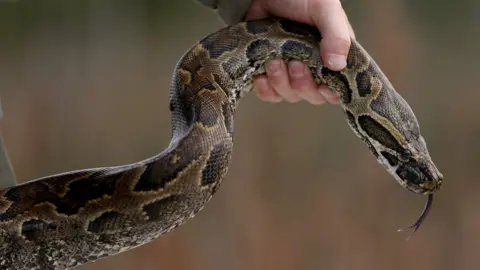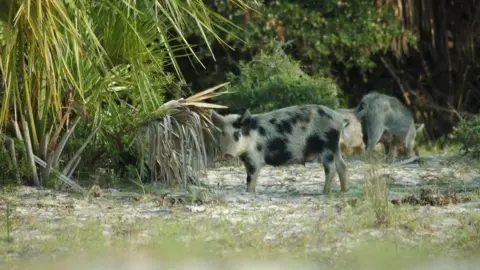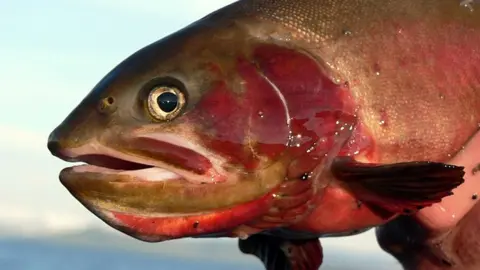US national parks face 'crisis' over invasive animal species
 Getty Images
Getty ImagesInvasive animal species represent a crisis for United States national parks, experts have said, in a call for widespread, systemic action.
More than half of national parks are threatened by invasive animal species, but the threat has gone unaddressed, according to a new paper.
The panel of experts said coordinated efforts and partnerships would be essential for success.
The paper was published in the journal Biological Invasions.
National parks span more than 85 million acres and can be found in all 50 states. They are home to the country's most beloved natural wonders and well-known historic sites. Since 1916, more than 400 parks have been established for protection.
The paper is the result of a three-year effort by a panel of experts, established by the National Park Service (NPS) in 2016 to assess the threat of invasive animals.
They note the NPS has had an invasive plant management programme for nearly two decades, but that invasive animals have not received the same attention.
"The issue of invasive animal species has long been acknowledged, but there has yet to be a concerted, coordinated effort to address the issue," said lead author Ashley Dayer, an assistant professor in the department of fish and wildlife conservation at Virginia Tech in Blacksburg.
A survey identified 1,409 populations of invasive animals made up of 331 species across the parks. Of those invasive populations, only 23% have management plans and only 11% are under control.
 National Park Service
National Park ServiceThose populations can be found across ecosystems, from lakes, rivers and reefs to forests, grasslands and deserts. And all kinds of animals are represented, including mammals, birds, reptiles and insects.
The impacts of invasive animal species vary, but they can cause a loss of park wildlife, damage natural ecosystems, hurt visitor experiences and be expensive to control.
A number of individual parks have addressed their unique issues with invasive species with some success. The authors say a transformative, service-wide programme could help others follow suit.
"There's 419 national parks - not every park is going to have a cadre of biologists that have the experience and the horsepower to deal with the problems," said David Hallac, co-author of the paper and superintendent of the National Parks of Eastern North Carolina.
He recognised that each park will have to address their issues with invasive animal species differently, but said making it a priority across the agency will help those parks get the support they need to do so.
"By having a service-wide programme, we can have a group of folks become a resource you can call to share examples of successful programmes and help parks prepare their own management plans."
Mr Hallac pointed to the NPS Invasive Plant Program as a model for providing this type of support. Established in 2000, the programme provides parks with technical assistance and policy guidance in dealing with invasive plant species.
'Python hunters'
Burmese pythons, native to South East Asia, have ravaged Florida's wildlife. Estimates say there are tens of thousands of them across the state, including all of Everglades National Park.
 Getty Images
Getty ImagesPythons entered the environment after being released by pet owners and, in the absence of natural predators, have proliferated.
Scientists say the invasive snakes - which can grow to be more than 20ft (6m) long and weigh more than 200lb (91kg) - are likely the main reason that mammal populations have declined in Everglades National Park.
An established removal programme authorises individuals to catch and kill the pythons.
The "python hunters", as they have been called, are mostly members of the public. They are paid and are allowed to use firearms to hunt.
Thousands of snakes have been removed thanks to the programme, but pythons remain a significant ecological threat.
Dropping dead fish to save fish
In Yellowstone National Park, non-native lake trout were illegally introduced to Yellowstone Lake in the 1980s and 1990s. The population flourished as they devoured the Yellowstone cutthroat trout, a native species and an important food for other native animals.
 National Park Service
National Park ServiceSince confirming the presence of lake trout in 1995, the NPS has made concerted efforts to manage the population. The most common method is netting and removing the voracious fish.
Another strategy involved inserting tracking devices into the fish that would send out sounds in the water, leading scientists to the spawning sites. Scientists could then target and kill the fish.
One method involves dropping decomposing dead fish - which decreases the available oxygen - on top of the spawning site to suffocate the eggs.
Cutthroat trout populations are still struggling, but more than two decades of efforts have yielded promising results.
